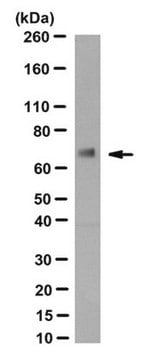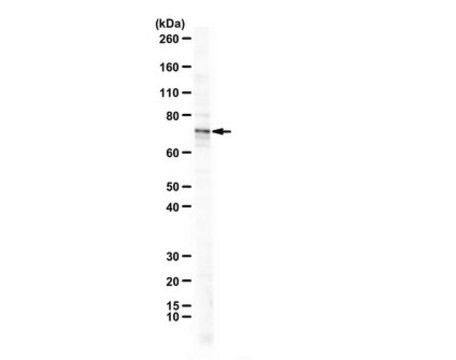MABF3038
Anti-Rhinovirus Capsid VP1 Antibody, clone HRV-18003
Synonim(y):
HRV-capsid VP1
About This Item
Polecane produkty
pochodzenie biologiczne
mouse
Poziom jakości
forma przeciwciała
purified antibody
rodzaj przeciwciała
primary antibodies
klon
HRV-18003, monoclonal
masa cząsteczkowa
calculated mol wt 242.824 kDa
observed mol wt ~32 kDa
oczyszczone przez
using protein G
reaktywność gatunkowa
virus
opakowanie
antibody small pack of 100
metody
ELISA: suitable
inhibition assay: suitable
western blot: suitable
izotyp
IgG2aκ
sekwencja epitopowa
N-terminal half
numer dostępu Protein ID
numer dostępu UniProt
temp. przechowywania
-10 to -25°C
Specyficzność
Immunogen
Zastosowanie
Evaluated by Western Blotting with recombinant Rhinovirus Capsid VP1 protein.
Western Blotting Analysis: A 1:125 dilution of this antibody detected recombinant Rhinovirus Capsid VP1 protein.
Tested Applications
Functional Assay A representative lot of this antibody exhibited strong activity in in vitro antibody dependent cellular phagocytosis (ADCP) assay. (Behzadi, M.A., et al. (2020). Sci Rep.;10(1):9750).
Western Blotting Analysis: A representative lot detected HRV-18003 recognizes VP1 in Western Blotting applications (Behzadi, M.A., et al. (2020). Sci Rep.;10(1):9750).
ELISA Analysis: A representative lot detected HRV-18003 recognizes VP1 in ELISA applications (Behzadi, M.A., et al. (2020). Sci Rep.;10(1):9750).
Note: Actual optimal working dilutions must be determined by end user as specimens, and experimental conditions may vary with the end user.
Opis wartości docelowych
Postać fizyczna
Rekonstytucja
Przechowywanie i stabilność
Inne uwagi
Oświadczenie o zrzeczeniu się odpowiedzialności
Not finding the right product?
Try our Narzędzie selektora produktów.
Kod klasy składowania
12 - Non Combustible Liquids
Klasa zagrożenia wodnego (WGK)
WGK 2
Temperatura zapłonu (°F)
Not applicable
Temperatura zapłonu (°C)
Not applicable
Certyfikaty analizy (CoA)
Poszukaj Certyfikaty analizy (CoA), wpisując numer partii/serii produktów. Numery serii i partii można znaleźć na etykiecie produktu po słowach „seria” lub „partia”.
Masz już ten produkt?
Dokumenty związane z niedawno zakupionymi produktami zostały zamieszczone w Bibliotece dokumentów.
Nasz zespół naukowców ma doświadczenie we wszystkich obszarach badań, w tym w naukach przyrodniczych, materiałoznawstwie, syntezie chemicznej, chromatografii, analityce i wielu innych dziedzinach.
Skontaktuj się z zespołem ds. pomocy technicznej








